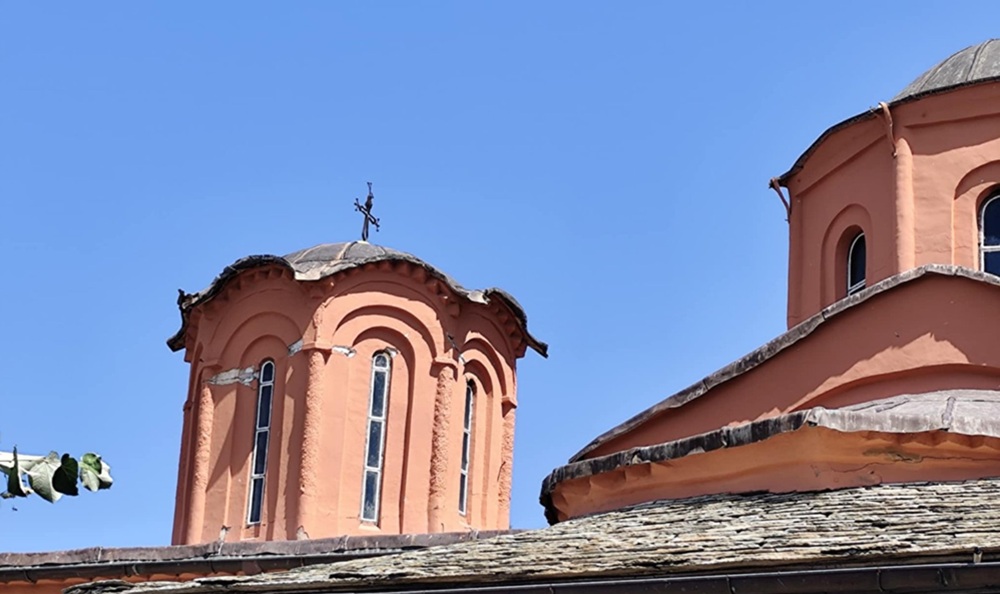
On the peninsula of Mount Athos on 7 June 2025, at 15:46, a powerful earthquake of 5.3 Richter, the strongest of the sequence of dozens of tremors that preceded and followed it, occurred. It was preceded, on 15 February, by a 4.7 magnitude earthquake, which caused several damages to temples and residential buildings (wings) of the monasteries and their annexes. The epicentre of the earthquake of 7 June was located in the sea area near the coastal monasteries of Dochiariou and Xenophontos.
Minister of Culture Lina Mendoni made the following statement: “Immediately after the earthquake of June 7, the Ministry of Culture through its competent services, and I personally, are in constant contact with the representatives of the Holy Monasteries. The Ephorate of Antiquities of Halkidiki and Mount Athos, with a team of archaeologists and conservators, headed by its head George Skiadaresis, is present in Athos, from the day after the earthquake, and will remain there until the completion of all the autopsies and thorough inspections of all the affected monuments. As in the past, as many times as needed, the Ministry of Culture, being fully aware of the immense archaeological, historical and spiritual importance of Mount Athos, is present in order to heal traumas and damages according to the principles of science and ethics“.
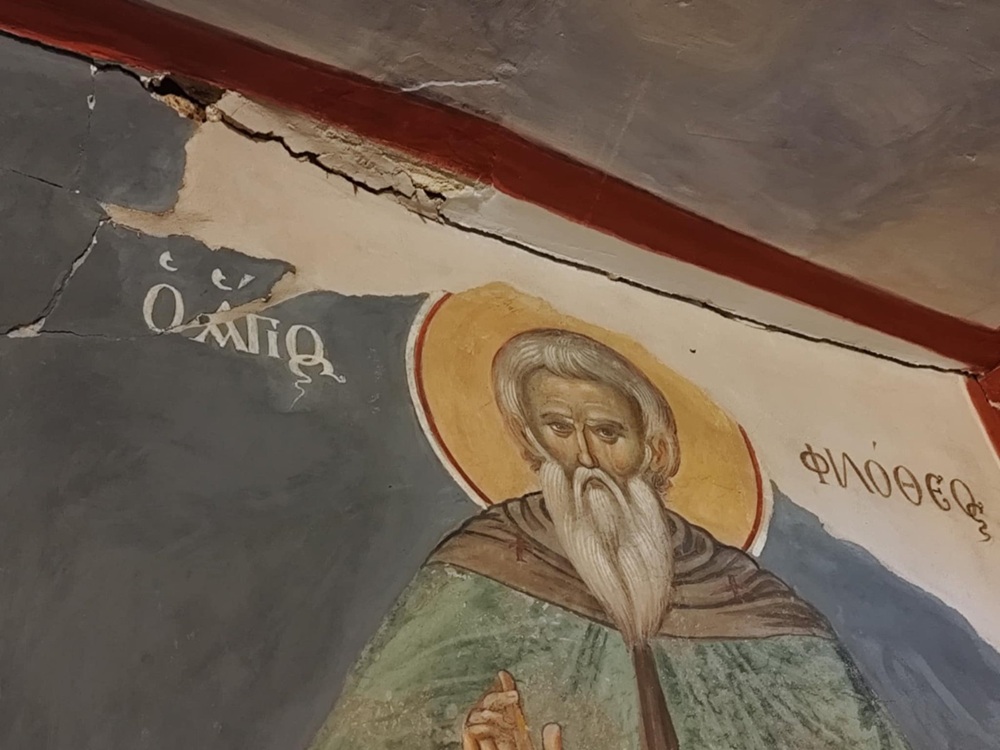
The damages recorded by the Ephorate of Antiquities of Halkidiki and Mount Athos are as follows:
In the Monastery of Xenophontos:
The Ephorate’s team during the autopsy in the old catholic, a monument, of the end of the 10th century, recorded with frescoes of the 16th century, found that the earthquake caused severe cracks in the domes, both in the main temple and in the lite, activating the old cracks, mainly in arches that had been closed. The cracks, in the interior frescoed surfaces, caused, in some places, even detachments of the painted layer, up to limited scale falls of coatings, with frescoes. Several of these damages were caused by the earthquake of 15 February 2025, but the recent earthquake showed a deterioration. Immediately following the damage caused by the February 15 earthquake, the Curator’s Office, with conservation crews, had applied salvage measures on the murals in places where the cracks were caused in order to hold back detached paintings. This action prevented more extensive damage to the frescoes.
It should be noted that the fall of a small metal chandelier in the nave caused minor damage to the 11th century marble floor.
For the old catholic of the Monastery of Xenophontos and given its historical value, it has been proposed, apart from the completion of immediate rescue measures on the frescoes, the preparation of a series of studies, with the aim of strengthening the monument as a whole and to definitively address older pathogenies. In the south-west wing of the monastery, small-scale cracks were observed on the frescoes of the chapel of St. Euphemia. In the new katholikon, built in 1819, with contemporary frescoes by Hieromonk Loukas Xenofontinos, there were slight cracks in places. Recent work to strengthen the monument, with metal tractors, prevented further damage. On the contrary, severe cracking occurred in the exonarthex of the church (without frescoes), which had not been reinforced with tractors.
Monastery of Docheiariou:
The present katholikon (main church) of the Docheiariou Monastery dates to the second half of the 16th century and is a reconstruction of an older building from the 12th century. It features wall paintings from 1568 attributed to the renowned painter of the Cretan School, Tzortzis. In the past, cracks had developed in the vaults and the two domes of the narthex. The Ephorate of Antiquities of Chalkidiki and Mount Athos had implemented emergency measures, mainly using gauze and, in certain spots, grouting of the cracks. These fissures worsened with the seismic sequence of the past year, but even more so with the recent earthquake of June 7, 2025.
It is noted that in the refectory of the monastery—a building from 1547, with a T-shaped floor plan and wall paintings from 1676 and 1700—older cracks were reactivated, even though they had been previously sealed with newer mortars. In addition, detachments of the painted layer from the supporting masonry were observed. Furthermore, in the passageway—the corridor leading from the katholikon to the refectory—as well as in the area of the miraculous icon of the Panagia Gorgoepikoos, which features wall paintings from the early decades of the 18th century, the reopening of older cracks was observed along the outline of the arches’ tympana.
At the Docheiariou Monastery, the Ministry of Culture and Sports, through the Ephorate of Antiquities of Chalkidiki and Mount Athos, has already deployed a team of conservators implementing protective measures in the refectory and the passageway. A conservators’ team conducted an inspection to assess the condition of the katholikon’s frescoes and to document damages in the monastery’s chapels.
At the Pantokratoros Monastery, the inspection recorded the condition of the katholikon’s frescoes as well as those in the monastery’s chapels. An inspection is also being conducted today at Vatopedi, while at Simonos Petra damages have been noted in the central wing and in some fresco areas.
It is noted that during the current programming period, works are underway for the “Structural restoration of the katholikon of the Holy Monastery of Docheiariou, Mount Athos” and the “strengthening of the supporting structure of the katholikon of the Holy Monastery,” carried out by the Technical Service of the Holy Community of Mount Athos. The Ephorate of Antiquities of Chalkidiki and Mount Athos is participating correspondingly with two sub-projects, expected to be completed by the end of 2025. As part of the project, to address the monument’s structural issues, metal tie rods are being installed throughout the katholikon. The Ephorate monitors the drilling works and, where necessary, applies additional temporary protective measures. The conservation of the katholikon’s frescoes is expected to begin soon, funded by the Aigeas Non-Profit Cultural and Charitable Organization of Athanasios and Marina Martinos. All studies for the above projects have been approved following the recommendation of the Central Archaeological Council (KAS). A comprehensive assessment of the damages across all the Holy Monasteries is expected to be completed by the end of the week.


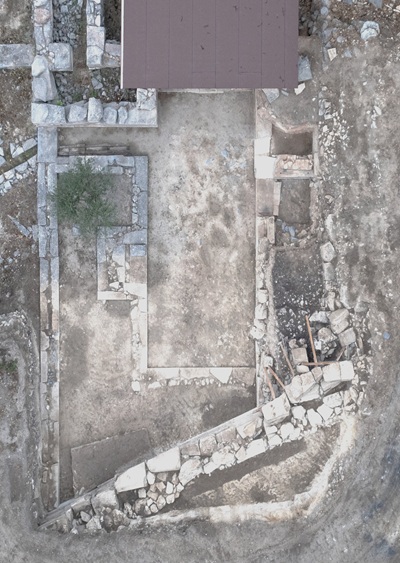
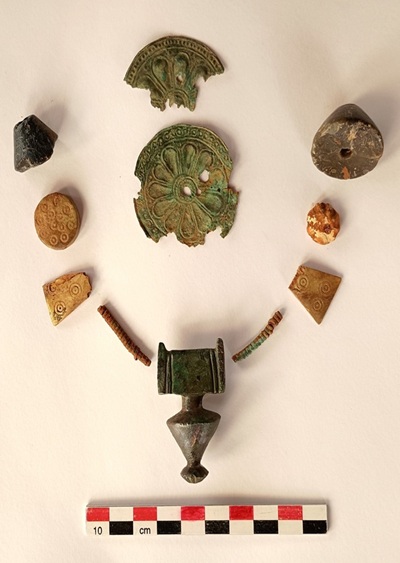
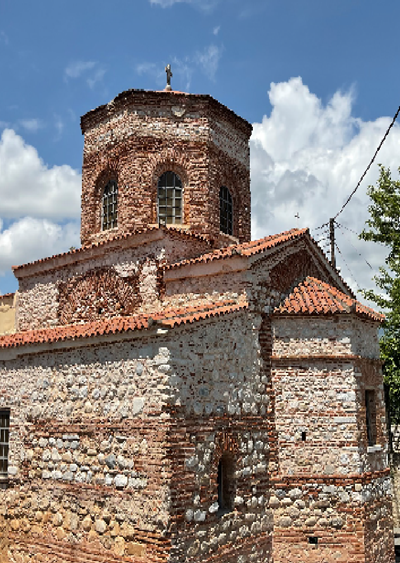


Leave A Comment